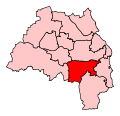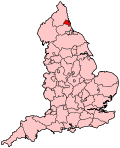Washington and Sunderland West (UK Parliament constituency)
Coordinates: 54°53′28″N 1°29′56″W / 54.891°N 1.499°W
| Washington and Sunderland West | |
|---|---|
|
Borough constituency for the House of Commons | |
|
Boundary of Washington and Sunderland West in Tyne and Wear for the 2010 general election. | |
|
Location of Tyne and Wear within England. | |
| County | Tyne and Wear |
| Electorate | 70,177 (December 2010) |
| Current constituency | |
| Created | 2010 |
| Member of parliament | Sharon Hodgson (Labour) |
| Created from | Houghton and Washington East, Gateshead East and Washington West, Sunderland North, Sunderland South |
| Overlaps | |
| European Parliament constituency | North East England |
Washington and Sunderland West is a constituency[n 1] represented in the House of Commons of the UK Parliament since its 2010 creation by Sharon Hodgson, a member of the Labour Party.[n 2]
Members of Parliament
| Election | Member[1] | Party | |
|---|---|---|---|
| 2010 | Sharon Hodgson | Labour | |
Constituency profile
The town of Washington has a well-preserved historic centre with a museum dedicated to the first United States president, on its outskirts, the family home of George Washington. Notwithstanding its tourism appeal, workless claimants who were registered jobseekers were in November 2012 higher than the national average of 3.8%, at 5.7% of the population based on a statistical compilation by The Guardian, and equal to the North East average.[2]
Boundaries
Washington and Sunderland West has electoral wards:
- Castle, Redhill, St Anne's, Washington Central, Washington East, Washington North, Washington South, Washington West in the City of Sunderland[3]
History
Parliament accepted the Boundary Commission's Fifth Periodic Review of Westminster constituencies to create this constituency for the General Election 2010.
- Forerunners
It is composed of elements of the following predecessors: Houghton and Washington East; Gateshead East and Washington West; Sunderland North; and Sunderland South.
- Selection of first MP
Following a ballot of members on 8 September 2007 Sharon Hodgson MP was selected as the Labour candidate, she represented 38% of the new seat which came from her previous seat of Gateshead East and Washington West which was abolished.
- Political history
All of the predecessor seats were held with majorities exceeding 5,000 votes and 5% of the vote before the 2010 election. Electoral calculus, an academic website, gave a provisional ranking as the 28th-safest Labour seat in the United Kingdom, and the 11th-safest Labour seat in England based on the results of 2005.[4]
Election results
Elections in the 2010s
| Party | Candidate | Votes | % | ± | |
|---|---|---|---|---|---|
| Labour | Sharon Hodgson | 24,639 | 60.7 | 5.8 | |
| Conservative | Jonathan Gullis | 11,699 | 28.8 | 10.0 | |
| UKIP | Bryan Foster | 2,761 | 6.8 | 12.8 | |
| Liberal Democrat | Thomas Appleby | 961 | 2.4 | 0.3 | |
| Green | Michal Chantkowski | 514 | 1.3 | 1.7 | |
| Majority | 12,940 | 31.9 | 3.4 | ||
| Turnout | 40,574 | 60.3 | 5.7 | ||
| Labour hold | Swing | -2.1 | |||
| Party | Candidate | Votes | % | ± | |
|---|---|---|---|---|---|
| Labour | Sharon Hodgson | 20,478 | 55.0 | | |
| UKIP | Aileen Casey | 7,321 | 19.6 | | |
| Conservative | Bob Dhillon | 7,033 | 18.9 | | |
| Green | Anthony Murphy | 1,091 | 2.9 | N/A | |
| Liberal Democrat | Dominic Haney | 993 | 2.7 | | |
| TUSC | Gary Duncan | 341 | 0.9 | N/A | |
| Majority | 13,157 | 35.3 | |||
| Turnout | 37,257 | 54.6 | |||
| Labour hold | Swing | ||||
For 2015, the British National Party announced Pauline Renwick as a candidate,[6] but she failed to stand.[7]
| Party | Candidate | Votes | % | ± | |
|---|---|---|---|---|---|
| Labour | Sharon Hodgson* | 19,615 | 52.5 | | |
| Conservative | Ian Cuthbert | 8,157 | 21.8 | | |
| Liberal Democrat | Peter Andras | 6,382 | 17.1 | | |
| BNP | Ian McDonald | 1,913 | 5.1 | | |
| UKIP | Linda Hudson | 1,267 | 3.3 | | |
| Majority | 11,458 | 30.7 | |||
| Turnout | 37,334 | 53.2 | | ||
| Labour hold | Swing | |
|||
- * Served as an MP for Gateshead East and Washington West in the 2005–2010 Parliament
2010 vote share changes and swing are based on notional results (a calculation of how the seat would have voted if it had existed at the previous election).
Notes and references
- Notes
- ↑ A borough constituency (for the purposes of election expenses and type of returning officer)
- ↑ As with all constituencies, the constituency elects one Member of Parliament (MP) by the first past the post system of election at least every five years.
- References
- ↑ Leigh Rayment's Historical List of MPs – Constituencies beginning with "W" (part 1)
- ↑ Unemployment claimants by constituency The Guardian
- ↑ 2010 post-revision map Greater London and metropolitan areas of England
- ↑ Electoral calculus by statistics modeller, Martin Baxter see Electoral Calculus
- ↑ "Election Data 2015". Electoral Calculus. Archived from the original on 17 October 2015. Retrieved 17 October 2015.
- ↑ http://www.chroniclelive.co.uk/news/local-news/election-2015-washington-sunderland-west-8650719
- ↑ https://yournextmp.com/person/7079/pauline-renwick
- ↑ "Election Data 2010". Electoral Calculus. Archived from the original on 17 October 2015. Retrieved 17 October 2015.
- ↑ http://www.sunderland.gov.uk/CHttpHandler.ashx?id=8437&p=0
- ↑ http://news.bbc.co.uk/1/shared/election2010/results/constituency/e95.stm
See also
- List of United Kingdom Parliament constituencies
- List of Parliamentary constituencies in Tyne and Wear
- Houghton and Sunderland South
- Sunderland Central

